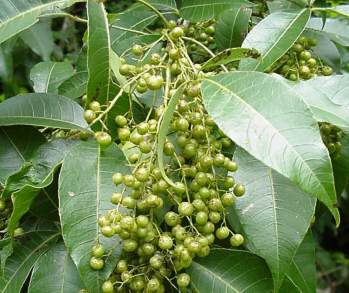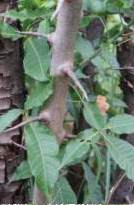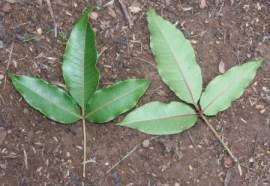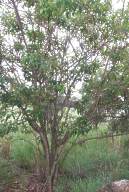Searsia chirindensis
Searsia chirindensis (Baker f.) Moffett
Family: Anacardiaceae
Common names: red currant (Eng.); bos-taaibos (Afr.); motha-thaa (North Sotho); umhlakothi (Xhosa); inhlokoshiyane enkulu (Xhosa); muvhadela-phanga (Venda)
SA Tree No: 380
Introduction
The red currant, Searsia chirindensis, is an attractive, African tree with lovely reddish autumn foliage. It is common throughout the eastern part of South Africa and is often grown in gardens. Together with the kiaat, Pterocarpus angolensis, this species has been chosen as the Tree of the Year for 2003.

Description
Description

The red currant is a semi-deciduous shrub to small tree, 6-10 m high (although exceptional specimens may reach 20 m). Young and coppicing branches are armed with spines, although the mature tree is spineless.
The flowers are small, yellowish green and are borne in clusters at the ends of the branches from August to March. Male and female flowers occur on separate trees. The fruits, which are round, shiny, slightly fleshy, dark reddish brown and 4-7 mm in diameter, are borne from December to March, in heavy clusters which can weigh down the branches.

The large leaves, which may grow to 130 mm long, have three leaflets and are dark green, turning red before falling in autumn. The margin of the leaves is entire and usually undulate and ends in a tapering tip. The midrib is pinkish and usually sunken above and prominent below. The leaf stalk may be up to 70 mm long and is also pinkish red. The young leaves are reddish.
Distribution and habitat
Distribution description
This is a widespread African species occurring from Tanzania in the north to the Cape in the south. In South Africa it occurs from Swellendam in Western Cape along the coastal belt, through Eastern Cape and KwaZulu-Natal, through the Natal midlands and up the escarpment into Mpumalanga and the eastern part of Limpopo [Northern Province]. In occurs naturally in forests, along forest margins, in riverine bush and scrub forest and rocky hillsides.
Derivation of name and historical aspects
History
Most of the species grown in southern Africa, belonging to the genus Rhus have been placed in Searsia. Searsia was named after Paul B. Sears (1891-1990) who was head of the Yale School of Botany. The red currant, S. chirindensis, is named after the Chirinda Forest in Zimbabwe, and is the largest of all the southern African Searsia species. There are about 91 taxa in southern Africa including the commonly cultivated karee (Searsia lancea) and witkaree (Searsia pendulina).
Ecology
Ecology
In its natural habitat, the bark and leaves of the red currant are browsed by black rhino and the leaves by kudu, nyala, bushbuck and red duiker. The ripe fruits are a favourite of many species of bird (including louries, bulbuls, barbets, white-eyes, pigeons) as well as monkeys.
Uses
Use
The sap of this tree is used in traditional medicine for treating heart complaints. The bark is also used to strengthen the body, to stimulate circulation and in the treatment of rheumatism and mental disorders.
The sapwood is yellowish and the heartwood a rich reddish brown. The heartwood is heavy and strong and makes attractive furniture. The wood has historically been used for wagon wood and for turning as well as for small tools and implements. The Venda name, muvhadela-phanga, literally means 'wood for knife handles'.
The red currant makes an excellent garden tree with its lovely autumn foliage. It is also attractive when in fruit and will attract various fruit-eating birds to the garden. The red currant bush (Ribes rubrum) from which jams and sauces are made is not indigenous to South Africa.
Growing Searsia chirindensis
Grow

As for most tree species, the red currant is best grown from seed with the seed germinating after 5-8 weeks. The seeds should be sown fresh for best germination results. There are also reports that it can be easily grown from truncheons and semi-hardwood cuttings.
The red currant is a fast-growing tree (up to 1 m per year) andcan be grown in full sun or partial shade. It should be planted in well-drained, composted soil. It does not have an aggressive root system. It should be pruned from an early age if a single-stemmed specimen tree is desired; if left unpruned it will grow into a multi-stemmed large shrub. It will tolerate moderate frosts and is drought hardy.
References
- COATES PALGRAVE, K. 1984. Trees of southern Africa, edn 2. Struik, Cape Town.
- GRANT, R. & THOMAS, V. 1998. Sappi tree spotting: KwaZulu-Natal. Jacana, Johannesburg.
- JOFFE, P. 1993. The gardener's guide to South African plants. Delos, Cape Town.
- JOHNSON, D. & JOHNSON, S. 1993. Gardening with indigenous trees and shrubs. Southern Books, Halfway House, Gauteng.
- LEISTNER, O.A. (ed.). 2000. Seed plants of southern Africa: families and genera. Strelitzia 10. National Botanical Institute, Pretoria.
- MOFFETT, R.O. 2007. Name changes in the Old World Rhus and recognition of Searsia (Anacardiaceae). Bothalia 37(2):165-175
- PALMER, E. & PITMAN, N. 1972. Trees of southern Africa. Balkema, Cape Town.
- POOLEY, E. 1993. The complete field guide to trees of Natal, Zululand and Transkei. Natal Flora Publications Trust, Durban.
- VAN WYK, A.E. (Braam). & VAN WYK, P. 1997. Field guide to trees of southern Africa. Struik, Cape Town.
- VENTER, F. & VENTER, J. 1996. Making the most of indigenous trees. Briza Publications, Pretoria.
- VON BREYTENBACH, J. et al. 2001. Pocket list of southern African indigenous trees. Briza Publications & Dendrological Foundation, Pretoria.
Credits
Sharon Turner
Witwatersrand National Botanical Garden
10 January 2003
Updated July 2008
Plant Attributes:
Plant Type: Shrub, Tree
SA Distribution: Eastern Cape, KwaZulu-Natal, Limpopo, Mpumalanga, Western Cape
Soil type: Sandy, Loam
Flowering season: Early Summer, Late Summer, Autumn
PH: Neutral
Flower colour: Yellow
Aspect: Full Sun, Morning Sun (Semi Shade), Afternoon Sun (Semi Shade)
Gardening skill: Easy
Special Features:
Horticultural zones











Rate this article
Article well written and informative
Rate this plant
Is this an interesting plant?
Login to add your Comment
Back to topNot registered yet? Click here to register.